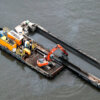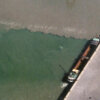Deltas are low-lying land areas at the mouths of rivers, making them fertile areas attractive for people to live and work and yet extremely vulnerable.
Low-lying and vulnerable
Today deltas belong to the most densely populated areas in the world, with about 500 million people live in or near river deltas. With extremely fertile soil and easy access to fishing, as well a perfect place for large ports and harbours, they have become hubs of industry and trade.
Yet, deltas, with land hardly above sea level or most often below it, are quite vulnerable to natural disasters.
Land subsidence
Land subsidence is also threatening deltas. Studies indicate that subsidence or sinking is worsened by the impacts of human activity, such as upstream sediment collection caused by reservoirs, dams, accelerated sediment compaction, and control of river channels. These circumstances often subject deltas to flooding and require frequent attention to their sea defences.
Deltas & climate change
Left to themselves, deltas are not necessarily vulnerable and can be self-sustaining. When natural processes run their course, sufficient sediment is transported to keep a delta growing at the same rate as a rise in sea level. An equilibrium between sediment deposits and erosion will be maintained.
This, however, has not been the case for several centuries. Dikes, dams and other “hard” technical engineering solutions have been put in place to regulate deltas for the benefit of people living nearby.
Ironically, the result of these interventions is that erosion of the delta front and land subsidence have increased and the ability of deltas to adapt to transformative circumstances like climate change has decreased.
The presence of large populations adds to the severity of loss of lives and assets if and when something goes wrong. Climate change and rising sea levels have increased this vulnerability.
Not all deltas are the same
Deltas are in fact very diverse, but they are usually classified in three different types:
- river-dominated deltas, in which wave and tide movements are relatively weak;
- wave-dominated deltas, where broad, sandy lobes form creating a smooth arched form with large, broad sandy beaches; and
- tide-dominated deltas at the mouth of a river, where tides occur twice daily, quickly expanding and deepening.
Management strategies for deltas
These different deltas demand different types of management strategies, which include different approaches to sediment management. Historically, technical strategies such as building dams, dikes and creating polders have been used. More recently non-technical, more natural processes sometimes known as the “building with nature” approach are being implemented.
Protecting deltas
Worldwide, low-lying delta areas are increasingly confronted with the challenges of urbanisation, economic development, accelerated sea level rise, subsidence and climate change.
At the same time, people increasingly realise that environmentally sustainable development of deltas is crucial to long-term survival. Ongoing research at universities, by government and by the private sector, including the dredging industry, are seeking innovative approaches to protect deltas. These solutions seek to align the interests of economic development and care for the environment and find a dynamic equilibrium between land and water.

























